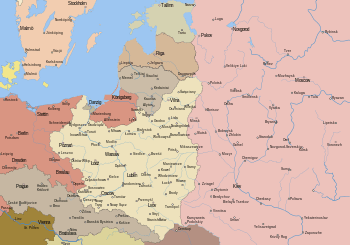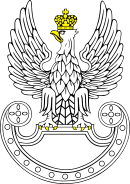Aftermath of the Polish–Soviet War
The Aftermath
According to the British historian A. J. P. Taylor, the Polish-Soviet War "largely determined the course of European history for the next twenty years or more.[...] Unavowedly and almost unconsciously, Soviet leaders abandoned the cause of international revolution."[1][2] Certainly the Bolsheviks' defeat in the war prevented Poland from becoming another Soviet republic and likely prevented Germany, Czechoslovakia and other nearby states from sharing a similar fate.
Soviet Communism was not eliminated, however, but only contained for a generation. Russia kept control of substantial western territories and their vast resources. Soon after the war officially ended, groups of Soviet-sponsored bandits and undercover agents began raiding Polish eastern frontier, prompting Poland to create a special, elite Border Defence Corps (Korpus Ochrony Pogranicza) to combat those constant incursions. A second Soviet effort at expansion was more successful. In August 1939 the Soviet Union signed the Molotov-Ribbentrop Pact with Nazi Germany and in cooperation with the latter invaded Poland on September 17, 1939, ensuring Poland's defeat in the Polish Defensive War of 1939. The Soviet occupation of eastern Poland rivaled in atrocities the German occupation of the remainder of the country. Persons who were deemed dangerous by the Communist authorities were subject to sovietization, forced resettlement, and imprisonment in labor camps (the Gulags), or were simply executed, as in the case of Polish officers in the Katyn massacres. Having served in the Polish-Soviet War on the side of Poland was punishable with death. After Poland had been occupied by the Red Army in 1944, Soviet atrocities included persecutions and prosecutions of Polish Home Army soldiers and executions of their leaders. In the aftermath of World War II, the Soviet Union succeeded in acquiring control of more territory than Imperial Russia had and partly fulfilled Lenin's original dream of bringing communist revolution to Germany. Until 1989, while Communists held power in a People's Republic of Poland, the Polish-Soviet War was either minimized in significance or misportrayed in Polish and other Soviet bloc countries' history books, for instance typically citing Poland as the aggressive initiator of the war on behalf of the Entente.
Much of what Poland had won during the 1920 war was lost in the peace negotiations that were characterized by many as short-sighted and petty. In 1921 Piłsudski was no longer the Head of State and was only an observer during the Riga negotiations, which he called "an act of cowardice". Due to the military defeat, the Bolsheviks offered the Poland substantial territorial concessions in the contested borderland areas, including the city of Minsk. However, the Polish delegation, pressured by the League of Nations, moderated the peace terms and signed the Peace of Riga on March 18, 1921, splitting the disputed territories in Belarus and Ukraine between Poland and Bolsheviks. The Ukrainians led by Symon Petliura had been in alliance with Poland, but by the Riga treaty the Ukrainian alliance was effectively ended. Piłsudski disapproved the treaty and the apparent betrayal of an ally, he then told the Ukrainians, "Gentlemen, I deeply apologize to you".
The treaty actually violated Poland's military alliance with Ukraine, which had explicitly prohibited a separate peace, consequently it worsened relations between Polish state and its Ukrainian minority, a feeling that would eventually lead to ethnic violence in the 1930s and 1940s.

The Polish military successes in autumn 1920 allowed Poland to reclaim the city of Wilno, but the control over city had been transferred to Lithuanians by the retreating Soviets. With Lithuanians unwilling to enter into an alliance with Poland, and wishing to avoid a full-out conflict and international condemnation, Poland staged a fake rebellion by Polish army units (under command by Gen. Lucjan Żeligowski) in the Wilno area, which allowed the Polish army to take control of the city on 9 October 1920. The fighting ended that month. Despite the Poles' claim to it, the League of Nations asked Poland to withdraw, a request which Poland denied. France, however, did not wish to antagonize Poland, seen as an ally against both Germany and USSR, thus the League of Nations demands were not enforced, and Poland kept Wilno under a puppet government of Komisja Rządząca Litwy Środkowej. A plebiscite was carried out and the Wilno Sejm voted on 20 February 1922 for incorporation into Poland. This would worsen Polish-Lithuanian foreign relations for many decades to come and was one of the reasons Piłsudski's Międzymorze federation was never formed. Repercussions of this still continue (though to a diminishing extent) to affect the foreign relations among these countries.
The outcome of the Polish-Soviet War was welcomed by some Polish politicians such as Roman Dmowski, who favored a relatively small, ethnically rather homogeneous state. It was also a death blow to Piłsudski's dream of reviving the powerful and multicultural Polish-Lithuanian Commonwealth in the form of a "Międzymorze Federation".
Piłsudski's military and political victory ensured that the armed forces became an important national institution in the new government. His reputation as the creator of the miracle at Vistula had vastly risen, and the National Democrats (endecja) lost the post-war elections. The new president Gabriel Narutowicz elected in 1922 was a socialist politician. In 1926, after Poland had experienced several years of political uncertainty and weak leadership, Piłsudski eventually took over the state in a coup d'état (the May Coup), assuming the posts of minister of defense and general inspector of the army.
The Treaty of Riga led to ethnic Poles granted autonomy within USSR. These Poles under Soviet jurisdiction suffered from the Great Purge and other repressions of the late 1930s. The Ukrainian minority in Poland received some internal autonomy within the southeastern voivodeships of Poland, but plans for a broader autonomy or federative union were never realized.
Military strategy in the Polish-Soviet War influenced Charles de Gaulle, an instructor with the Polish Army who fought in several of the battles. He and Władysław Sikorski were the only military officers who, based on their experiences of this war, correctly predicted how the next one would be fought. In World War II they rose to command of their respective armed forces in exile. This war also influenced the Polish military doctrine, which for the next 20 years would stress the mobility of the elite cavalry units.
Among the technical advances associated with the Polish-Soviet War was one that would affect the course of World War II. In the Polish-Soviet War, Poland's Marshal Piłsudski and his staff enjoyed a vast advantage from their military intelligence decrypting ("breaking") Red Army radio messages. These were encrypted in primitive ciphers and codes, and often involved incredible breaches of security by Bolshevik cipher clerks. The Polish cryptologists and commanders were thus regularly able to look over the shoulders of the Bolshevik commanders, including Mikhail Tukhachevski himself, and their superior, Leon Trotsky.1 (In this regard, the Red Army repeated mistakes that had been made in World War I by its Tsarist predecessor vis-a-vis the German Army, and that had contributed fundamentally to the Russian 1914 defeat at Tannenberg.2) Poland's cryptological achievements in the Polish-Soviet War were a prelude to the spectacular achievements of her General Staff's Cipher Bureau (Biuro Szyfrów), from December 1932, in decrypting German Enigma machine ciphers. Their subsequent decryption in World War II by the Western Allies at Bletchley Park – given a flying head-start by Poland's having revealed her techniques and technology to Britain and France at Warsaw a month before the outbreak of war – substantially affected the course of the war.3
POWs
The treatment of the prisoners of war during the course of the war was far from adequate: both countries were experiencing great economic and social difficulties, and often unable to care even for their own populations.
During the Polish-Soviet War, between 80,000 and 85,000 Soviet soldiers became prisoners of war and were held in Polish POW camps4. The conditions in these camps were bad, as the newly recreated Polish state lacked many basic capabilities and had few resources to construct them. Thus the existing camps, many of which were adapted from World War I German and Russian facilities or constructed by the prisoners themselves, were not adequate for holding the large number of prisoners, who suffered from hunger, bad sanitation and inadequate hygiene. Between 16,000 (Polish figures) and 20,000 (Russian figures) died as a result of communicable diseases which raged in the camps.[3]
The condition of Polish POWs held by the Soviets during this time is less well known. There have been, however, reports of Soviet army executing Polish POWs when no POW facilities were available.5 Units commanded by Gayk Bzhishkyan murdered more than 1000 of POWs.[4]
After 1922 the Polish and Russian prisoners were also exchanged among two sides. Ekaterina Peshkova the chairwoman of organization Assistance to Political Prisoners (Pompolit, Помощь политическим заключенным, Помполит).[5] was awarded by an order of Polish Red Cross for her participation in the exchange of POWs after the Polish-Soviet War.[6][7]
Notes
- Ścieżyński, Radjotelegrafja...
- Kahn, The Code-Breakers.
- Kozaczuk, Enigma.
- Waldemar Rezmer, Zbigniew Karpus, Gennadij Matvejev, "Krasnoarmieitsy v polskom plenu v 1919–1922 g. Sbornik dokumentov i materialov", Federal Agency for Russian Archives, Moscow 2004
- Karpus, Zbigniew, Alexandrowicz Stanisław, Zwycięzcy za drutami. Jeńcy polscy w niewoli (1919-1922). Dokumenty i materiały (Victors behind the fences. Polish POWs (1919–1922). Documents and materials). Wydawnictwo Uniwersytetu Mikołaja Kopernika w Toruniu, Toruń, 1995, ISBN 83-231-0627-4.
References
- ↑ Ronald Grigor Suny, The Soviet Experiment: Russia, the USSR, and the Successor States, Oxford University Press, ISBN 978-0-19-508105-3, Google Print, p.106
- ↑ Davies, Norman, White Eagle, Red Star: the Polish-Soviet War, 1919–20, Pimlico, 2003, ISBN 978-0-7126-0694-3. (First edition: New York, St. Martin's Press, inc., 1972.)Page ix.
- ↑ POLISH-RUSSIAN FINDINGS ON THE SITUATION OF RED ARMY SOLDIERS IN POLISH CAPTIVITY (1919–1922). Official Polish government note about 2004 Rezmar, Karpus and Matvejev book. Accessed on February 20, 2008.
- ↑ http://www.caw.wp.mil.pl/biuletyn/b18/b18_11.pdf
- ↑ http://2002.novayagazeta.ru/nomer/2002/81n/n81n-s39.shtml
- ↑ (Russian) Yaroslav Leontiev Dear Ekaterina Pavlovna, Russian Germany, N24 -2005
- ↑ (Russian) Fighters for the Human Rights, Novaya Gazeta, N81, 2002
See Polish-Soviet War#References.


